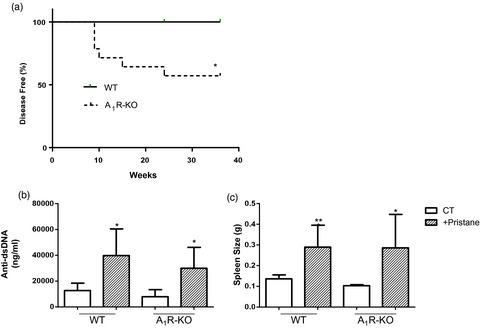当前位置:
X-MOL 学术
›
Clin. Exp. Immunol.
›
论文详情
Our official English website, www.x-mol.net, welcomes your feedback! (Note: you will need to create a separate account there.)
A1 and A2A adenosine receptors play a protective role to reduce prevalence of autoimmunity following tissue damage
Clinical & Experimental Immunology ( IF 4.6 ) Pub Date : 2021-04-24 , DOI: 10.1111/cei.13607 Reut Riff 1 , Oshri Naamani 1, 2 , Julia Mazar 3 , Yosef S Haviv 4 , Cidio Chaimovitz 4 , Amos Douvdevani 1, 4
Clinical & Experimental Immunology ( IF 4.6 ) Pub Date : 2021-04-24 , DOI: 10.1111/cei.13607 Reut Riff 1 , Oshri Naamani 1, 2 , Julia Mazar 3 , Yosef S Haviv 4 , Cidio Chaimovitz 4 , Amos Douvdevani 1, 4
Affiliation

|
Adenosine is a potent modulator that has a tremendous effect on the immune system. Adenosine affects T cell activity, and is necessary in maintaining the T helper/regulatory T cell (Treg) ratio. Adenosine signalling is also involved in activating neutrophils and the formation of neutrophil extracellular traps (NETs), which has been linked to autoimmune disorders. Therefore, adenosine, through its receptors, is extremely important in maintaining homeostasis and involved in the development of autoimmune diseases. In this study, we aim to evaluate the role of adenosine A1 and A2A receptors in involvement of autoimmune diseases. We studied adenosine regulation by NETosis in vitro, and used two murine models of autoimmune diseases: type I diabetes mellitus (T1DM) induced by low-dose streptozotocin and pristane-induced systemic lupus erythematosus (SLE). We have found that A1R enhances and A2AR suppresses NETosis. In addition, in both models, A1R-knock-out (KO) mice were predisposed to the development of autoimmunity. In the SLE model in wild-type (WT) mice we observed a decline of A1R mRNA levels 6 h after pristane injection that was parallel to lymphocyte reduction. Following pristane, 43% of A1R-KO mice suffered from lupus-like disease while WT mice remained without any sign of disease at 36 weeks. In WT mice, at 10 days A2AR mRNA levels were significantly higher compared to A1R-KO mice. Similar to SLE, in the T1DM model the presence of A1R and A2AR was protective. Our data suggest that, in autoimmune diseases, the acute elimination of lymphocytes and reduction of DNA release due to NETosis depends upon A1R desensitization and long-term suppression of A2AR.
中文翻译:

A1 和 A2A 腺苷受体发挥保护作用,降低组织损伤后自身免疫的发生率
腺苷是一种有效的调节剂,对免疫系统具有巨大的影响。腺苷影响 T 细胞活性,对于维持辅助性 T 细胞/调节性 T 细胞 (T reg ) 比例至关重要。腺苷信号传导还参与中性粒细胞的激活和中性粒细胞胞外陷阱 (NET) 的形成,这与自身免疫性疾病有关。因此,腺苷通过其受体对于维持体内平衡极其重要,并参与自身免疫性疾病的发展。在本研究中,我们旨在评估腺苷 A 1和 A 2A受体在自身免疫性疾病中的作用。我们在体外研究了 NETosis 对腺苷的调节,并使用了两种自身免疫性疾病的小鼠模型:低剂量链脲佐菌素诱导的 I 型糖尿病 (T1DM) 和降植烷诱导的系统性红斑狼疮 (SLE)。我们发现 A 1 R 增强 NETosis,A 2A R 抑制 NETosis。此外,在这两种模型中,A 1 R 敲除(KO)小鼠都容易发生自身免疫。在野生型 (WT) 小鼠的 SLE 模型中,我们观察到注射降植烷后 6 小时A 1 R mRNA 水平下降,这与淋巴细胞减少平行。降植烷后,43% 的 A 1 R-KO 小鼠患有狼疮样疾病,而 WT 小鼠在 36 周时仍然没有任何疾病迹象。在 WT 小鼠中,第 10 天时 A 2A R mRNA 水平显着高于 A1R-KO 小鼠。与 SLE 类似,在 T1DM 模型中,A 1 R 和 A 2A R的存在具有保护作用。我们的数据表明,在自身免疫性疾病中,NETosis 引起的淋巴细胞的急性消除和 DNA 释放的减少取决于 A 1 R 脱敏和 A 2A R的长期抑制。
更新日期:2021-04-24
中文翻译:

A1 和 A2A 腺苷受体发挥保护作用,降低组织损伤后自身免疫的发生率
腺苷是一种有效的调节剂,对免疫系统具有巨大的影响。腺苷影响 T 细胞活性,对于维持辅助性 T 细胞/调节性 T 细胞 (T reg ) 比例至关重要。腺苷信号传导还参与中性粒细胞的激活和中性粒细胞胞外陷阱 (NET) 的形成,这与自身免疫性疾病有关。因此,腺苷通过其受体对于维持体内平衡极其重要,并参与自身免疫性疾病的发展。在本研究中,我们旨在评估腺苷 A 1和 A 2A受体在自身免疫性疾病中的作用。我们在体外研究了 NETosis 对腺苷的调节,并使用了两种自身免疫性疾病的小鼠模型:低剂量链脲佐菌素诱导的 I 型糖尿病 (T1DM) 和降植烷诱导的系统性红斑狼疮 (SLE)。我们发现 A 1 R 增强 NETosis,A 2A R 抑制 NETosis。此外,在这两种模型中,A 1 R 敲除(KO)小鼠都容易发生自身免疫。在野生型 (WT) 小鼠的 SLE 模型中,我们观察到注射降植烷后 6 小时A 1 R mRNA 水平下降,这与淋巴细胞减少平行。降植烷后,43% 的 A 1 R-KO 小鼠患有狼疮样疾病,而 WT 小鼠在 36 周时仍然没有任何疾病迹象。在 WT 小鼠中,第 10 天时 A 2A R mRNA 水平显着高于 A1R-KO 小鼠。与 SLE 类似,在 T1DM 模型中,A 1 R 和 A 2A R的存在具有保护作用。我们的数据表明,在自身免疫性疾病中,NETosis 引起的淋巴细胞的急性消除和 DNA 释放的减少取决于 A 1 R 脱敏和 A 2A R的长期抑制。


























 京公网安备 11010802027423号
京公网安备 11010802027423号